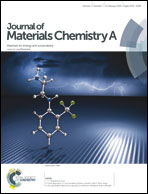A redox mediator doped gel polymer as an electrolyte and separator for a high performance solid state supercapacitor
Abstract
A stable and effective redox-mediator gel electrolyte has been prepared by doping indigo carmine (IC) into a polyvinyl alcohol sulfuric acid polymer system (PVA–H2SO4), and a high performance solid state supercapacitor is fabricated by utilizing activated carbon as electrodes and the prepared gel polymer (PVA–H2SO4–IC) as an electrolyte and separator. The PVA–H2SO4–IC gel polymer has excellent bending, compressing and stretching mechanical properties. As expected, the ionic conductivity of the gel polymer electrolyte increased by 188% up to 20.27 mS cm−1 while introducing IC as the redox mediator in the PVA–H2SO4 gel electrolyte. Simultaneously, specific capacitance is increased by 112.2% (382 F g−1) and energy density (13.26 W h kg−1) is also increased. Furthermore, the fabricated device shows superior charge–discharge stability. After 3000 cycles, its capacitive retention ratio is still as high as 80.3%. This result may be due to the fact that the IC can act as a plasticizer and redox mediator, and the supercapacitor combines the double-layer characteristic of carbon-based supercapacitors and the faradaic reaction characteristic of batteries energy-storage processes.


 Please wait while we load your content...
Please wait while we load your content...